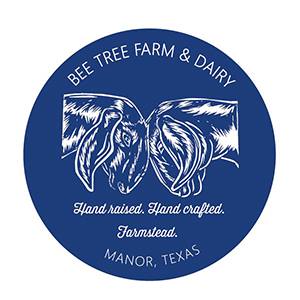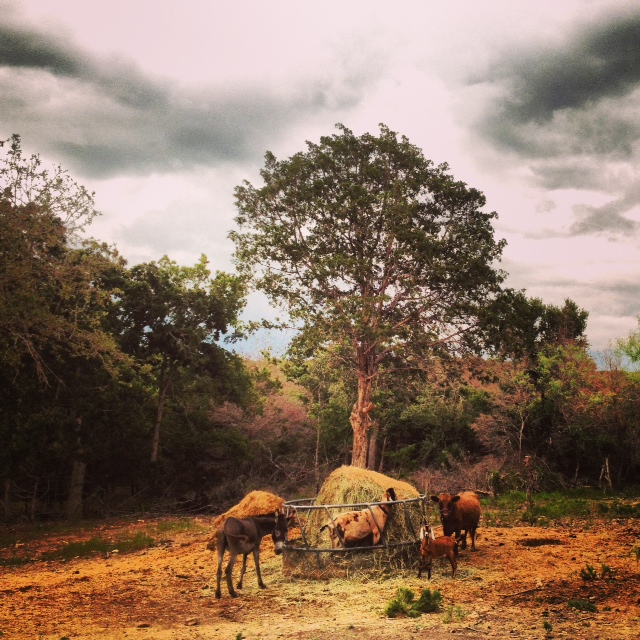Farm School: Day 2
It’s fitting to end the second day of farm school like this; feet propped on the homemade wood and metal coffee table on the porch, dark Mexican beer at my side, watching a golden hen peck at leaves and grasshoppers. Tonight we put out a fresh bale of the hay just stocked on our semi-annual Farm Insurance Run; the title somehow helps us swallow the cost of nearly a year’s worth of hay. I can see the big stock gathered around the new bale right now, tearing into hay so fresh it smells like April come wafting over the fenceline. If there’s a better view, I don’t know it.
Today, Farm School was mostly about growing non-animal materials. The morning started with a fascinating presentation about soil composition and compost and the meek little 6th grader that still lurks inside of me absolutely geeked out over charts about the evolution of rock and animal matter into dirt. I listened attentively but let 25% of my brain wander back through the halls of high school and then meander over the grassy knolls of my college lawns – where was I led astray from science; something that’s always captivated my attention (not an easy feat)? Maybe it was chemistry class. Or physics? Regardless, I want a do-over. The bulk of our day eventually moved to the figurative dissection of produce pests and the predators that manage them. We learned the principles of Integrated Pest Management (IPM), a plan that encourages preventative measures and early pest identification, using chemical pesticides as the very last resort. Based on that discussion I’m positive my tomatoes are infested with thrips, the entire family of hoppers (including katydids), tomato hornworms, aphids, tigers, and bears. I’ve done a piss-poor job of attacking any of these pests through IPM, having ignored them all entirely. But at least now I am forced to stop blaming weeds and heat for curled and yellow leaves and splotchy fruit. Damn you thrips!
The shortest presentation of the day, Kevin Anderson, who directs the Center on Environmental Research at Hornsby Bend, was my favorite. In addition to his lengthy resume as farmer that spans states and continents, the man is a skilled performer, artfully injecting poetry into relevant information about ecosystem approaches to farming. His suggested list of books was lengthy, and I’ll share a few here if, like me, you never know where to start with such things. The obvious writers (Wendell Berry) aren’t on my list – but a few of the lesser knowns are:
- Where Our Food Comes From – Gary Paul Nabhan
- Growing Food in a Hotter, Drier Climate – Gary Paul Nabhan
- The Contrary Farmer – Gene Logsdon
- Holy Shit: Managing Manure to Save Mankind – Gene Logsdon
And some periodicals/websites:
Mr. Anderson reminded us that no one knows for sure how to “do it right” and that if your soil is working, if your animals are thriving, you’ve got a good start. Keep at it. He pointed out that, until Charles Darwin devoted nearly the second half of his life to the study of earthworms, it was a common belief they were invasive soil pests. The fact is, we’re still learning, and the majority of successful growing (beasts and fruits and vegetables) remains miraculous. He shared an anecdote of his own early days, sipping coffee at 12 years old at the edge of a cow pasture, peering over the fence. “I was monitoring them,” he said, “because that’s an important part of this work” since you must (he then quoted another farmer, Dick Richardson), “Assume what you’re doing is wrong and manage accordingly.” In this case, manage means monitor, so he monitored with vigilance over his morning coffee. If they become ill, you may not immediately know why, but you’ll know right away.
Why do we farm, Mr. Anderson asked? Wendell Berry addresses this question, the very one that has likely baffled the minds of city dwellers since the rise of industry and since meat started to appear chilled and pink, (not really) “clean” on styrofoam beds nestled together in mega-grocery store fridges, their gory origins buried under cellophane:
Why do farmers farm, given their economic adversities on top of the many frustrations and difficulties normal to farming? And always the answer is: “Love. They must do it for love.” Farmers farm for the love of farming. They love to watch and nurture the growth of plants. They love to live in the presence of animals. They love to work outdoors. They love the weather, maybe even when it is making them miserable. They love to live where they work and to work where they live.
― Wendell Berry, Bringing it to the Table: Writings on Farming and Food
It was a good day. I left feeling inspired but boggled. I connected with another person interested in goats, although I was wary of giving the advice he asked for since I’ve hardly dipped my toe in this sometimes tepid, sometimes boiling water. Our first presenter, also an appreciator of poetry, ended his session with Whitman. And I think about the words now at the end of today, thunder rolling somewhere out east and a wind rustling leaves long dead from this endless drought, despite the coming rain. The animals chew fresh hay like it’s their last supper and stand just yards from where we only recently found our perished goat.
Now I am terrified at the earth! It is that calm and patient,
It grows such sweet things out of such corruptions,
It turns harmless and stainless on its axis, with such endless successions of diseas’d corpses,
It distils such exquisite winds out of such infused fetor,
It renews with such unwitting looks, its prodigal, annual, sumptuous crops,
It gives such divine materials to men, and accepts such leavings from them at last.
-Walt Whitman, This Compost!

